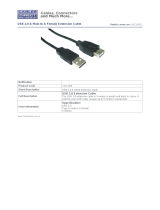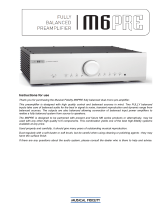Generic Information
The information in the following sections is common to
all ATC electronics products. We recommend that you
read this along with the safety warnings opposite before
continuing to read the pages dedicated specifically to
the CDA2 Mk2 unit.
Installation: A
TC equipment has been designed to be free
standing either within an equipment stand or simpl y on a
convenient item of furniture.There are no special ventilation
requirements (but please see notes on amplifiers below). It is
recommended that at least 100mm (4 inches) clearance be left
behind a unit for plugs and cables.
ATC equipment has been designed to remain po
wered-up in
standby mode unless it is to be unused for a long period of time.
Power dissipation will make the unit warm to the touch in either
standby or operational mode. Temperature stability will be
reached after approximately three hours from mains switch-on.
Full audio performance is available immediately.
ATC preamplifiers should be located as close to the source
components as practically possible to minimise the cable
length.The outputs however are capable of driving up to 50
metres of good quality cable; therefore it is practical to locate
the preamplifier a distance away from the monitor or power
amplifier(s).
ATC power amplifiers and integrated amplifiers should ideally
be located to minimise the cable lengths from both the source
components and the loudspeakers. Use of loudspeaker cables in
excess of 10 metres should be avoided if possible to prevent a
possible degradation in sound quality. Care must be taken to
ensure that ventilation holes in the top and bottom covers are
not obscured. Please contact ATC if the amplifier is to be
mounted in an enclosed area.
Mains Connection: The mains voltage to be used with the
CDA2 Mk2 is displayed on the rear panel. The mains cable has
been specifically supplied to comply with local statutory safety
approvals and alternatives should not be substituted. If you
intend to use your unit in an alternative territory, please contact
ATC for advice. ATC equipment MUST be earthed. Do not
remove the earth wire in the mains plug.
Fuses: Mains power supply fuses are fitted within the CDA2
Mk2, but they are not intended to be user replaceable. The
mains power supply fuse for the unit is located on the r ear
panel. Should the unit fail to switch on when the power switch
is operated, the fuse should be inspected. PLEASE ENSURE
THAT THE UNIT IS DISCONNECTED FROM THE MAINS
SUPPLY BEFORE INSPECTING OR REPLACING A FUSE.
Lift out the fuse holder cover using a small screwdriver, remove
the fuse and inspect it for damage. Fuses most often fail due to a
serious electrical fault. Only replace fuses with the same type as
that suspected to be blown. All fuses are 20mm “Type T anti
surge”. The fuse rating is printed on the rear panel adjacent to
the fuse. If a replacement fuse also fails then the unit should be
returned to ATC for service.
1:CDA2 Mk2 – Description
The CDA2 Mk2 Stereo CD Pre-Amplifier-DAC has been
designed to partner ATC active, and with an appropriate power
amplifier, passive loudspeaker systems. It incorporates two line-
level analogue stereo inputs on RCA phono sockets, together
with a 3.5mm Jack socket input, an internal CD Player system,
digital S/PDIF optical TosLink and coaxial inputs and a USB 2.0
interface. A main line level stereo output on RCA phono
sockets, true differential left and right outputs on XLR sockets
and a headphone output on a ¼˝ jack socket. components and
the loudspeakers. Please contact ATC if the amplifier is to be
mounted in an enclosed area.
2:Inputs
Selection of CDA2 Mk2 inputs is achieved via an input push
button mounted on the front panel, the selected input being
shown in the display window.
The CDA2 Mk2 will accept unbalanced RCA phono style input
plugs on Analogue inputs 1 and 2. Analogue input 2 will also
accept a 3.5mm stereo jack plug. The signal on unbalanced
phono inputs is present on the centre conductor and the signal
return is made via the screened outer. The ring of a 3.5mm
stereo jack input plug carries the right channel signal, the tip
carries the left channel and the body is the signal return for both
left and right channels. If there is any hum present on the output
this must be traced to its source and not suppressed by the
removal of screens and earths. Removal of the screen on an
unbalanced input will result in uncontrollably loud hum.
Connection to the Digital Inputs can be either Coaxial via
RCA phono style input plugs or Optical via TosLink connectors.
A computer running Windows or MAC OSX Operating Systems
can be connected directly to the CDA2 MkII via the rear panel
mounted USB type B socket. Operation with MAC OSX is
driverless. Machines running windows require installation of a
proprietary driver, available from the ATC website.
The input sockets are illustrated overleaf in Fig. 1.
3:Digital Inputs
The S/PDIF input on the CDA2 Mk2 supports 16bit and 24bit
PCM audio with the following sample rates:
44.1kHz, 48kHz, 88.2kHz, 96kHz, 192kHz*.
* 192kHz supported via coaxial input only.
The USB 2.0 interface supports 16bit, 24bit and 32bit PCM
audio with the following sample rates:
44.1kHz, 48kHz, 88.2kHz, 96kHz, 176.4kHz, 192kHz,
352.8kHz, 384kHz.
DSD playback is available over USB only. The following sample
rates are supported:
Mac OSX: DSD64 (2.8MHz), DSD128 (5.6MHz)
Windows: DSD64 (2.8MHz), DSD 128 (5.6MHz),
DSD256 (11.2MHz).













 1
1
 2
2
 3
3
 4
4
 5
5
 6
6
 7
7
 8
8
 9
9
 10
10
 11
11
 12
12
 13
13
Sandberg 502-73 Datasheet
 Cables Direct CDL-025 Datasheet
Cables Direct CDL-025 Datasheet
QUAD Vena II Owner's manual
Sitecom CN-212 Datasheet
HQ HQCA-A013/5.0 Datasheet
 Musical Fidelity M6PRE User guide
Musical Fidelity M6PRE User guide
Swissonic HAD-1 24 Bit / 96 kHz Stereo AD / DA Converter User manual
 Musical Fidelity MX-DAC Product information
Musical Fidelity MX-DAC Product information
ELEKTRA Nu-Vista CD - Musical Fidelity Owner's manual
Pro-Ject DAC Box S2 + Product information















